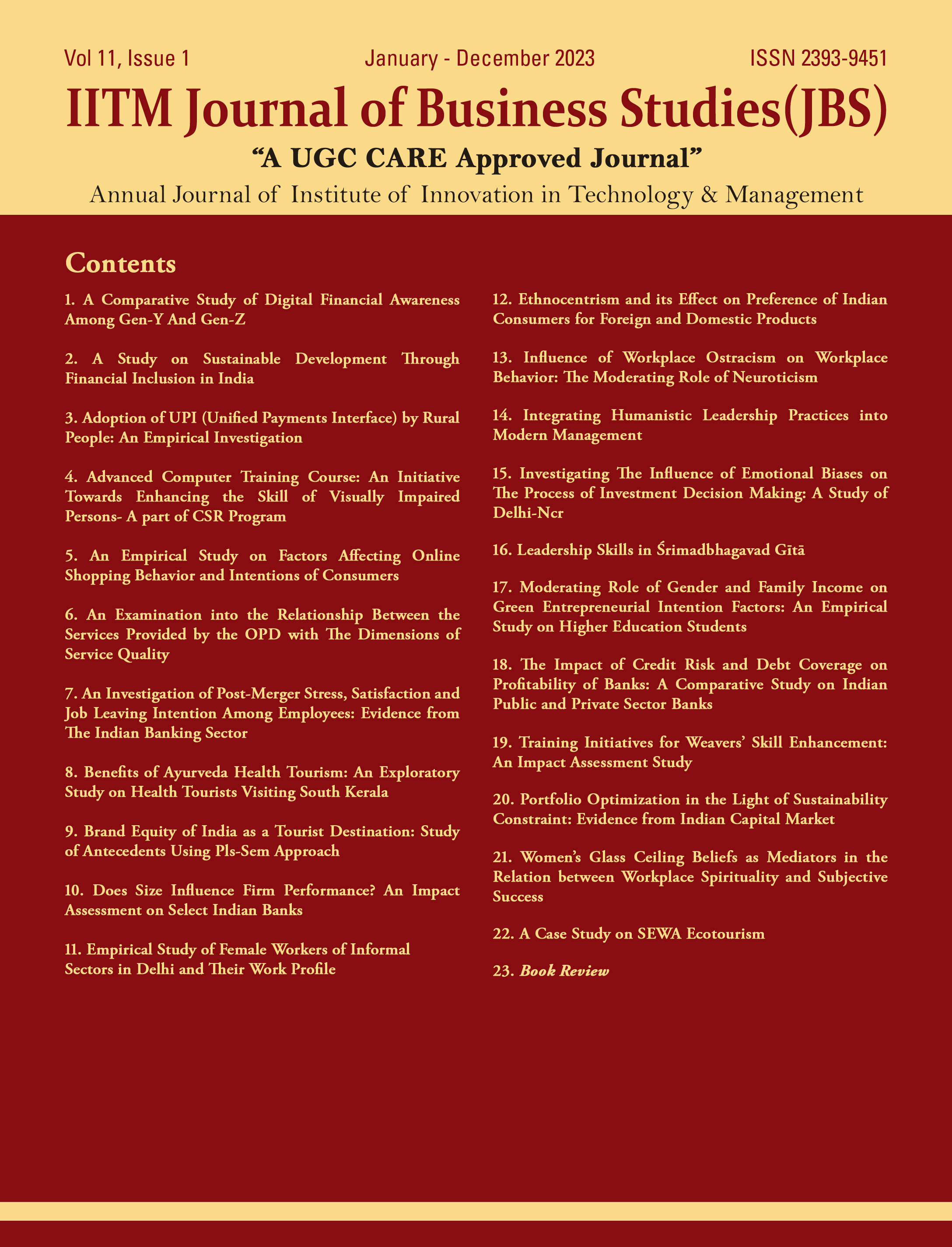Analysing Financial Performance of Indian Automobile Sector in context of achieving Sustainability
Keywords:
Sustainability, Start-Ups, Financial Performance, Capital Structure, Manufacturing Sector, Make in India, Automobile SectorAbstract
Manufacturing sector has occupied an important role in India’s Economic Development. India is globalising its product more worldwide by ensuring vocal about local products which in turns leading to more start-ups, self-production, and employment opportunities’. Self-reliant is leading India towards sustainability. Sustainability focuses on meeting the needs of the present without compromising the ability of future generations to meet their needs. In India, focus on Manufacturing sector have been increased to make India self-reliant and generate more employment opportunities. Prime Minister of India, Mr. Narendra Modi, had launched the ‘Make in India’ program to place India on the world map as a manufacturing hub and give global recognition to the Indian economy. The Government of India has taken several initiatives to promote a healthy environment for the growth of Manufacturing Sector in the country. The Manufacturing Sector of India has the potential to reach US$ 1 trillion by
2025 with impetus on developing industrial corridors and smart cities; the government aims to ensure holistic development of the nation. The corridors would further assist in integrating, monitoring, and developing a conducive environment for the industrial development and will promote advance practices in Manufacturing Sector. India is an attractive hub for foreign investments in the Manufacturing Sector. Several mobile phone, luxury and automobile brands, among others, have set up or are looking to establish their manufacturing bases in the country. In today’s COVID19 pandemic, there is focus of India to be self -reliant and every country is promoting its Manufacturing Sector. In this paper, financial performance and Capital structure of Automobiles sector listed on BSE 500 for last 10 years will be analysed to know the overall growth of this sector for making India self- reliant. Various parameters will be analysed in relation to ratios, trend analysis, descriptive statistics, correlation for predicting the growth of automobile sector in the last ten years. Data will be collected from CMIE Prowess. Government initiatives to boost up the manufacturing sector will also be analysed. This paper will help Government, Policy Makers, Industrialist, and the Economist to find more paved ways of economic development through automobile manufacturing sector.
References
Aulia, H., & Gandakusuma, I. (2020). The Effect of Capital Structure On Firm Performance of Manufacturing Companies In ASEAN 5 Country. In 23rd Asian Forum of Business Education (AFBE 2019) (pp. 473-477). Atlantis Press
Baby Shibitha., Dutta Chandan,. & kalita Bikash.(2012). Analysis of Capital Structure in Different Industries in India. Journal of Management in practice, Vol 1.
Chadha, S., & Sharma, A. K. (2015). Capital structure and firm performance: Empirical evidence from India. Vision, 19(4), 295-302. doi:http://dx.doi.org/10.1177/0972262915610852 4. Chaklader, B., & Chawla, D. (2016). A study of determinants of capital structure through panel data analysis of firms listed in NSE CNX 500. Vision, 20(4), 267-277. doi:http://dx.doi. org/10.1177/0972262916668700
Das, C. P., & Swain, R. K. (2018). INFLUENCE OF CAPITAL STRUCTURE ON FINANCIAL PERFORMANCE. Parikalpana: KIIT Journal of Management, 14(1), 161-171. doi:http://dx.doi. org/10.23862/kiit-parikalpana/2018/vl4/il/173256
Hedau, Amit 1 ; Singh, Shailender 2 ; Janor, Huwati (2018) Determinants of Capital Structure – A sector specific approach. Romanian Economic and Business Review; Brasov Vol. 13, Issue. 4, (Winter 2018): 14-30.
Robert, k., Richard, k., & Rono, p. (2020). The effect of capital structure on financial performance of firms in Kenya: evidence from firms listed at the Nairobi securities exchange
Mardones, J. G., & Cuneo, G. R. (2020). Capital structure and performance in Latin American companies. Economic Research-Ekonomska Istraživanja, 33(1), 2171-2188.
Modigliani F, Miller MH (1958) The cost of capital, corporation finance and the theory of investment. The American Economic Review 48: 261-297.
Mukherjee, S., & Mahakud, J. (2010). Growth opportunity and capital structure dynamics: Evidence from Indian manufacturing companies. Journal of Management Research, 10(3), 180-192.Retrieved from https://search.proquest.com/docview/816241788?accountid=195353
Mohammad, H. S., Bujang, I., & Taufik, A. H. (2019). Capital structure and financial performance of malaysian construction firms. Asian Economic and Financial Review, 9(12), 1306-1319. doi:http:// dx.doi.org/10.18488/journal.aefr.2019.912.1306.1319
Myers, S. C. (1984). Capital structure puzzle. Cambridge: National Bureau of Economic Research, Inc. doi:http://dx.doi.org/10.3386/w1393
Revathy, S., & Santhi, V. (2016). Impact of capital structure on profitability of manufacturing companies in India. Int J Adv Engg Tech/Vol. VII/Issue I/Jan.-March, 24, 28.
S. A. Jude Leon (2013). The Impact of Capital structure on Financial Performance of the Listed Manufacturing Firms in Sri Lanka. G.J.C.M.P, 2(5), 56-62.
Sofat, Rajni; Singh, Sukhdev (2017). Determinants of capital structure: an empirical study of manufacturing firms in India, International Journal of Law and Management; Patrington Vol. 59, Iss. 6, (2017): 1029-1045.
Titman, Sheridan and Roberto Wessels, (1988). The Determinants of Capital Structure Choice,” Journal of Finance 43, 1-19.
Vu, T., Le, T., & Nguyen, T. (2020). The impact of capital structure on the performance of construction companies: A study from Vietnam stock exchanges. Accounting, 6(2), 169-176.z 18. yange, A., Emmanuel, N. C., Rosemary, I. H., Ndudi, U. C., & Samuel, U. E. (2021). Effect of capital structure on firms performance in nigeria. Universal Journal of Accounting and Finance, 9(1), 15-23. doi:10.13189/ujaf.2021.090102
Harahap, I. M., Septiani, I., & Endri, E. (2020). Effect of financial performance on firms’ value of cable companies in indonesia. Accounting, 6(6), 1103-1110. doi:10.5267/j.ac.2020.7.008 20. Meiryani, Olivia, Sudrajat, J., & Daud, Z. M. (2020). The effect of firm’s size on corporate performance. International Journal of Advanced Computer Science and Applications, 11(5), 272-277. doi:10.14569/ IJACSA.2020.0110536
Susilo, D., Wahyudi, S., & Pangestuti, I. R. D. (2020). Profitability determinants of manufacturing firms in indonesia. International Journal of Economics and Business Administration, 8(2), 53-64. doi:10.35808/ijeba/443
